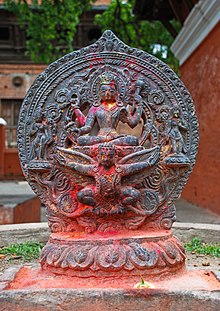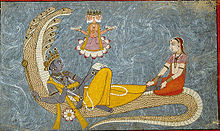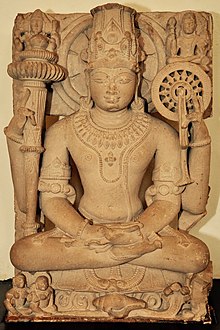Vishnu
![]()
This article is about the Hindu deity. For other meanings, see Vishnu (disambiguation).
Vishnu (Sanskrit विष्णु Viṣṇu [ˈʋɪʂɳʊ], etymology unclear) is one of the most important forms of the divine in Hinduism and occurs as early as the Vedas. In Vishnuism he is regarded as the manifestation of the Supreme. His Shakti, the feminine side of the divine, is Lakshmi, who is considered his wife.
Several Puranas tell about Vishnu, his incarnations are mentioned among others in the Bhagavatapurana.
Vishnu was first a Vedic deity, even though he used to be rather subordinate compared to today. In the Rigveda, Vishnu appears primarily as a god with cosmic significance. Originally he was probably a god of the sun, light and heat, who set time in motion, pervaded the universe and measured out space. He was among the Adityas, the sons of the goddess Aditi, who was also considered in part to be his wife. The Rigveda mentions Vishnu's important role in sacrifice several times, he was mainly a god of rituals and is also worshipped as the centre and pillar of the universe. Similarly, he watched over the sacrificial pillars of animals. Vishnu was also the creator of Maya, the primordial power and miraculous force of the Vedic gods. In three steps (Trivikrama), symbolizing the rising, peak and setting of the sun, he measured out the entire space as a dwarf figure who grew into a giant, took possession of all the three worlds (Triloka) and made it habitable for men and gods. This dwarf figure (Vamana) later became the fifth avatara of Vishnu in modern Hinduism. With the development of the Vedic era, the god Vishnu underwent a tremendous evolution. Along with the god Rudra, he is one of the great ascenders of Hinduism. In the course of time he took over more and more the classical task of Indra as a fighter against the "demons" and preserver of the world.

Vishnu riding on Garuda (sculpture in Lalitpur, Nepal)

Vishnu on the serpent Shesha in the primordial sea. Consort Lakshmi massages his feet as a gesture of worship, while from his navel, seated on a lotus flower, the four-headed creator Brahma appears.
Trimurti
Vishnu is part of the Trimurti, a conception of the "three figures" very well known in Hinduism. This consists of three aspects of the divine, which are related to the fundamental principles or forces of the cosmos:
- Creation: Brahma
- Conservation: Vishnu
- Destruction: Shiva
In the trinity the tasks are distributed: Vishnu is the divine form of preservation, as he maintains the Dharma in terms of a just cosmological and human order and for this purpose incarnates again and again as animal or human. Shiva, on the other hand, destroys and dissolves to make a new beginning possible, while Brahma is responsible for creation. In the Trimurti concept, these opposing values enter into a complementary union. Outside this Trimurti, however, both Vishnu and Shiva combine all three aspects. Vishnu too can be destructive: He uses the throwing disc (chakram), one of his four symbols, as a destructive weapon.
Shiva also contains all aspects outside the trinity. For those devotees who worship him as the supreme, the Shivaites, he is also regarded as the saviour, the benevolent one, as his name indicates. A divine form that unites the aspects of Vishnu and Shiva is Harihara.

Meditating Vishnu with mace (gada) and throwing disc (chakra)
View
Vishnu is usually depicted holding four insignias in his four hands:
- Throwing disc (chakra), which is hurled at the enemies in the course of a battle.
- snail horn (shankha), on which he blows on various occasions
- lotus flower (padma), among other things the symbol of wisdom and purity, because it is radiantly pure even in the dirtiest pond
- Mace (gada) with which he fights asuras.
Other
- On his head Vishnu wears a pot-like crown.
- His mount (vahana) is the half-man, half-eagle Garuda.
- In many depictions he rests as Narayana on the cosmic serpent Ananta or Shesha.
Questions and Answers
Q: Who is Vishnu?
A: Vishnu is the supreme godhead of Vaishnavism (Para Brahman or Nirguna Brahman) in puranas. He is one of the three main gods in Hinduism and is the supreme being in the Vaishnava tradition.
Q: What does Vishnu do?
A: Vishnu is the god of preservation, meaning that he protects the universe from being destroyed. It is believed that Vishnu holds the Earth and all living organisms.
Q: How many incarnations has Vishnu had so far?
A: According to Hindu religion, Vishnu has had nine incarnations so far with one yet to come called Kalki at the last Kali Yuga to destroy evil. His most famous incarnations are Rama, Krishna, Parashurama and Narasimha.
Q: Who is Lakshmi?
A: Lakshmi is Vishnu's wife and she is known as the goddess of wealth and fortune.
Q: What does Vishnu look like?
A: Vishnu usually shown with a light blue skin and four arms. He holds a lotus or Padma, an indestructible mace (Kaumodaki), a conch (Shankha) and an unstoppable disc (Sudarshana Chakra).
Q: What are Mahavishu Karanodakshayi, Garbhodaksayi, and Kshirodakashayi?
A: These are three forms of Vishanu which are expansions of Karanodakshayi Visnhu.
Search within the encyclopedia